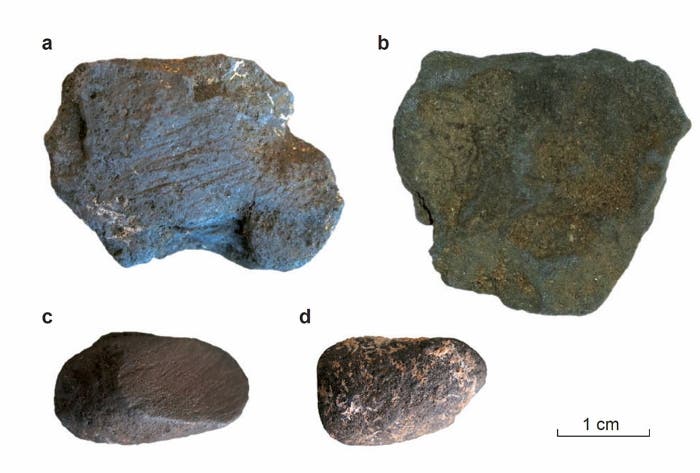Evidence points to the fact that Neanderthals used manganese dioxide, today commonly found in batteries, to light fires some 50,000 years ago.

Illustration by Zdenek Burian, 1958
The findings were made by researchers in the famous Pech-de-l’Azé I in South Western France, where Neanderthals congregated for many generations. In these caves, researchers found small black ‘blocs‘ — chunks of manganese oxides — which the Neanderthals used as pigments for paintings, body decorations and maybe even for symbolic expression. The team from Leiden University and Delft University of Technology reckoned however that if it was black pigments they need for decoration, soot and charcol should have been enough. These are readily available all the time because the Neanderthals knew how to build fires.

Manganese dioxide blocs from Pech de l’Azé (France), both unmodified (b and d) and abraded (a and c). Image by Peter Heyes
The team propose an alternative hypothesis: these manganese blocs were primarily used to start fires. Statistically designed combustion experiments and thermo-gravimetric (TGA) measurements demonstrate that manganese dioxide reduces wood’s auto-ignition temperature and substantially increases the rate of char combustion. Furthermore, fire places and the grinding of manganese dioxide blocs to powder found at the location supports this line of thought.
“We don’t know how Neanderthals made fire but given their skills with lithics, we might start with an assumption they used sparks and tinder,” study author Peter Heyes, a researcher at Leiden University, said in a press release. “We don’t bring it out particularly in the paper but manganese dioxide added to wood shavings or other tinder increases the efficiency with which the tinder captures a spark and lights.”
If true, then these findings provide a fresh new look into the cognitive abilities of Neanderthals. Complex use and altering of the environment is definitely a mark of ingineousity.
“Finding evidence to support a view on Neanderthal management of wood fuel resources is a very remote possibility,” Heyes added. “It could nevertheless have been an important aspect of subsistence. If Neanderthals could devote time and resources to collecting manganese dioxide for fire making, it is perhaps not unreasonable to assume they could manage wood fuel resources effectively.”
Findings appeared in the journal Nature.









